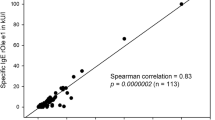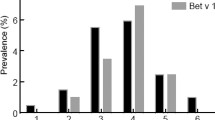Summary
Background: Alongside hazel, alder and birch pollen allergies, ash pollen allergy is a relevant cause of hay fever during spring in the European region. For some considerable time, ash pollen allergy was not routinely investigated and its clinical relevance may well have been underestimated, particularly since ash and birch tree pollination times are largely the same. Ash pollen extracts are not yet well standardized and diagnosis is therefore sometimes unreliable. Olive pollen, on the other hand, is strongly cross-reactive with ash pollen and is apparently better standardized. Therefore, the main allergen of olive pollen, Ole e 1, has been postulated as a reliable alternative for the detection of ash pollen sensitization.
Methods: To determine to what extent specific IgE against Ole e 1 in patients with ash pollen allergy is relevant, we included 183 subjects with ash pollen allergy displaying typical symptoms in March/April and positive skin prick test specific IgE against Ole e 1 (t224) and ash pollen (t25) and various birch allergens (Bet v 1, Bet v 2/v 4) in a retrospective study.
Results: A significant correlation was seen between specific IgE against Ole e 1 and ash pollen, but also to a slightly lesser extent between IgE against Ole e 1 and skin prick test with ash pollen, the latter being even higher than IgE and skin prick test both with ash pollen. No relevant correlation was found with birch pollen allergens, demonstrating the very limited cross-reactivity between ash and birch pollen.
Conclusion: It appears appropriate to determine specific IgE against Ole e 1 instead of IgE against ash pollen to detect persons with ash pollen allergy. Our findings may also support the idea of using possibly better standardized or more widely available olive pollen extracts instead of ash pollen extract for allergen-specific immunotherapy.
Similar content being viewed by others
Abbreviations
- Bet v:
-
Betula verrucosa
- CAP:
-
Capacity, ImmunoCAP®
- Fra e:
-
Fraxinus excelsior
- HMW:
-
High molcular weight
- IgE:
-
Immunglobulin E
- IHRP:
-
In-house reference preparation
- Ole e:
-
Olea europaea
- NaCl:
-
Sodiumchloride
- NPT:
-
Nasal provocation test
- SIT:
-
Specific immunotherapy
References
Poncet P, Senechal H, Clement G, Purohit A, Sutra JP, Desvaux FX et al. Evaluation of ash pollen sensitization pattern using proteomic approach with individual sera from allergic patients. Allergy 2010; 65: 571–580
Hemmer W, Focke M, Wantke F, Götz M, Jarisch R, Jäger S. Ash (Fraxinus excelsior)-pollen allergy in central Europe: specific role of pollen panallergens and the major allergen of ash pollen, Fra e 1. Allergy 2000; 55: 923–930
Barderas R, Purohit A, Papanikolaou I, Rodriguez R, Pauli G, Villalba M. Cloning, expression, and clinical significance of the major allergen from ash pollen, Fra e 1. J Allergy Clin Immunol 2005; 115: 351–357
Hrabina M, Purohit A, Oster JP, Papanikolaou I, Jain K, Pascal P et al. Standardization of an ash (Fraxinus excelsior) pollen allergen extract. Int Arch Allergy Immunol 2007; 142: 11–18
Niederberger V, Purohit A, Oster JP, Spitzauer S, Valenta R, Pauli G. The allergen profile of ash (Fraxinus excelsior) pollen: cross-reactivity with allergens from various plant species. Clin Exp Allergy 2002; 32: 933–941
Schmid-Grendelmeier P, Peeters AG, Wahl R, Wüthrich P. Zur Bedeutung der Eschenpollenallergie. Allergologie 1994; 17: 535–542
Palomares O, Swoboda I, Villalba M, Balic N, Spitzauer S, Rodriguez R et al. The major allergen of olive pollen Ole e 1 is a diagnostic marker for sensitization to Oleaceae. Int Arch Allergy Immunol 2006; 141: 110–118
Bousquet J, Guerin B, Hewitt B, Lim S, Michel FB. Allergy in the Mediterranean area. III: Cross reactivity among Oleaceae pollens. Clin Allergy 1985; 15: 439–448
Wahl R, Schmid-Grendelmeier P, Cromwell O, Wüthrich B. In vitro investigation of cross-reactivity between birch and ash pollen allergen extracts. J Allergy Clin Immunol 1996; 98: 99–106
Asero R. Analysis of hypersensitivity to oleaceae pollen in an olive-free and ash-free area by commercial pollen extracts and recombinant allergens. Eur Ann Allergy Clin Immunol 2011; 43: 77–80
Twaroch TE, Focke M, Civaj V, Weber M, Balic N, Mari A et al. Carrier-bound, nonallergenic Ole e 1 peptides for vaccination against olive pollen allergy. J Allergy Clin Immunol 2011; 128: 178–184 e7
Rodriguez R, Villalba M, Batanero E, Palomares O, Quiralte J, Salamanca G et al. Olive pollen recombinant allergens: value in diagnosis and immunotherapy. J Invest Allergol Clin Immunol 2007; 17 Suppl 1: 4–10
D’Amato G, Cecchi L, Bonini S, Nunes C, Annesi-Maesano I, Behrendt H et al. Allergenic pollen and pollen allergy in Europe. Allergy 2007; 62: 976–990
Alche JD, Castro AJ, Jimenez-Lopez JC, Morales S, Zafra A, Hammam-Khalifa AM et al. Differential characteristics of olive pollen from different cultivars: biological and clinical implications. J Invest Allergol Clin Immunol 2007; 17 Suppl 1: 17–23
Focke M, Marth K, Flicker S, Valenta R. Heterogeneity of commercial timothy grass pollen extracts. Clin Exp Allergy 2008; 38: 1400–1408
Focke M, Marth K, Valenta R. Molecular composition and biological activity of commercial birch pollen allergen extracts. Eur J Clin Invest 2009; 39: 429–436
Barderas R, Purohit A, Rodriguez R, Pauli G, Villalba M. Isolation of the main allergen Fra e 1 from ash (Fraxinus excelsior) pollen: comparison of the natural and recombinant forms. Ann Allergy Asthma Immunol 2006; 96: 557–563
Author information
Authors and Affiliations
Corresponding author
Additional information
German version www.springermedizin.de/allergo-journal
Conflict of interest
The authors state that there are no conflict of interest.
Cite this as Imhof K, Probst E, Seifert B, Regenass S, Schmid-Grendelmeier P. Ash pollen allergy — reliable detection of sensitization on the basis of IgE to Ole e 1. Allergo J Int 2014; 23: 78–83 DOI 10.1007/s40629-014-0010-8
Rights and permissions
About this article
Cite this article
Imhof, K., Probst, E., Seifert, B. et al. Ash pollen allergy: reliable detection of sensitization on the basis of IgE to Ole e 1. Allergo J Int 23, 78–83 (2014). https://doi.org/10.1007/s40629-014-0010-8
Received:
Accepted:
Published:
Issue Date:
DOI: https://doi.org/10.1007/s40629-014-0010-8




